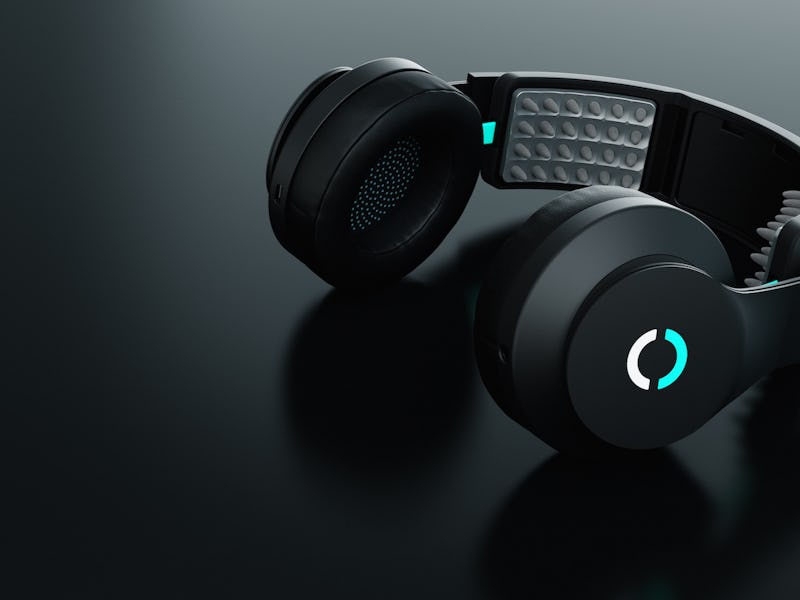These Headphones Promise to Stimulate Your Motor Cortex With Electrical Currents
Halo's founders hoped to "develop technology that allows anyone to unlock their brain's full potential."

Last week, a company called Halo Neuroscience released some over-ear headphones that promise to do a little bit more than just play music: These headphones are designed to stimulate your motor cortex and its neurons, and, in so doing, improve your exercises and make you a better athlete.
If your bullshit meter is already exploding, give it a momentary rest.
Neurostimulation has long been a boon to scientific studies’ exposure. You and I both want our brains to work better, and it’s tempting to believe that our neurons are at fault for our stupidity, unproductivity, laziness, and so on. If we could simply find a way to coax our neurons into doing a little extra work for us, to fire a bit more readily and communicate a bit more efficiently, then, perhaps, those shortcomings — stupidity, etc. — would dissipate. Perhaps.
The two brains behind Halo Neuroscience, Daniel Chao (CEO) and Brett Wingeier (CTO), believe they’ve demonstrated that the odds are a lot better than “perhaps.” Both creators are legitimate, albeit business-minded, doctors: Chao has an M.D. from Stanford, and Wingeier a Ph.D. in biomedical engineering from Tulane. Their first business venture was FDA-approved NeuroPace, which also used neurostimulation — but, in this case, to detect and preemptively ward off seizures in epileptics. NeuroPace also required surgical implantations, which Halo Sport — obviously — does not require.
The headphones are instead equipped with “primers” that maintain direct contact with your scalp and thereby transmit the current:
The Halo Sports are wireless, and boast a surprisingly clean design.
If you don a pair of Halo Sports, Chao and Wingeier say, you’ll get more out of your exercises. And become better at sports. (Jury’s still out on stupidity and unproductivity, but Chao and Wingeier aren’t making any claims about the headphones’ ability to curtail those faults. Their next product, on the other hand, will make such claims.) Along with the headphones, there’s an app that monitors your workout and controls the neurostimulation.
In Chao’s own words: “Halo was founded with a simple but ambitious goal: to develop technology that allows anyone to unlock their brain’s full potential.”
Before the science gets too involved, know that the United States Ski Team was one of several test subjects, and that they now claim to be committed believers. See for yourself:
And it’s not just them: A few MLB teams are rumored to be covertly using the technology, and, Chao explains, one of their “very first partners was actually the United States Special Operations Command” — the overseer of the Army, Navy, Marine Corps, and Air Force. Michael Johnson Performance, a training center for elite athletes is also involved, and its patrons clients — to say the least — speak highly of the tech:
The Halo Sports employ either sustained (tDCS) or pulsating currents that target your motor cortex. These neurons will then be more apt to fire. (You can’t just wear them while you Netflix and chill, though. If I may anthropomorphize neurons: your neurons will only learn to behave in this way if you’re wearing the headphones while you exercise.) Here’s Chao: “[The motor cortex] is both mission control and the battery that fires your muscles — i.e., it’s critical for both athletic skill and strength.”
Wingeier explains the excitation in more detail:
Current in the scalp, skull, and brain takes the form of movement of ions, in the general direction from one electrode to the other. When this current flow occurs, it is accompanied by an electrical field that is parallel to the current flow. Think of a current of water in a river — there is a gradient of potential energy from a point upriver to a point downriver. Same concept — in tissue, this gradient is the electrical field. The fields are small, since much of the current doesn’t make it through your skull (Miranda et al 2006, Clin. Neurophysiol. 117(7)). Luckily, neurons are very sensitive to electrical fields — it’s what they do.
When neurons are placed in an electrical field, they either get depolarized (a little more likely to fire) or hyperpolarized (a little less likely to fire). This depends on the geometry of the cell and the placement of the field, and was best modeled and analyzed by a scientist named Thomas Radman at CUNY (2009, Conf Proc IEEE Eng Med Biol). Radman figured all this out with math, and then turned around and showed that it all worked the same in real neurons (Radman et al. 2009, Brain Stimulation, following up on the work of Bikson et al. 2004, J Physiol). It gets better: because neurons in the motor cortex are so highly organized, and the excitatory cells have different geometry from the inhibitory cells, you can stimulate with a certain current at a certain position and have a reliable effect.
Chao and Wingeier ran extensive, large-scale, controlled studies that purport to prove that the effect is not a placebo. Olympic ski jumpers improved their jump forces by 31 percent, compared with the control group’s mere 18 percent. The Executive VP of Athletics for the U.S. Ski and Snowboard Association echoes these findings: “We’re seeing enhanced learning ability and enhanced power output.”
For now, the Halo Sports are limited to athletes in professional sports organizations — and those with deep pockets, $549 — and a passion for self-improvement. If you fit into either camp, you can test out Chao and Wingeier’s claims for yourself. And if you do, feel free to email me your independent findings.